Proton gradient - Study guides, Class notes & Summaries
Looking for the best study guides, study notes and summaries about Proton gradient? On this page you'll find 936 study documents about Proton gradient.
Page 2 out of 936 results
Sort by
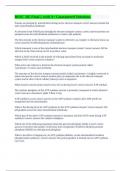
-
BIOC 385 Final || with A+ Guaranteed Solutions.
- Exam (elaborations) • 17 pages • 2024
-
Available in package deal
-
- $12.49
- + learn more
Protons are pumped by mitochondria during active electron transport correct answers outside the inner mitochondrial membrane. As electrons from NADH pass through the electron transport system, correct answers protons are pumped across the mitochondrial membrane to create a pH gradient. The first enzyme in the electron transport system is referred to as complex I, otherwise known as correct answers NADH-ubiquinone oxidoreductase. Which statement is true of the mitochondrial electron tran...

-
Biology 1406: Exam 3 Latest Version Graded A+
- Exam (elaborations) • 14 pages • 2024
- Available in package deal
-
- $9.99
- + learn more
Biology 1406: Exam 3 Latest Version Graded A+ autotrophs an organism able to build all the complex organic molecules that it requires as its own food source heterotroph an organism that cannot derive energy from photosynthesis or inorganic chemicals , and so must feed on other plants and animals, obtaining chemical energy by degrading their organic molecules cellular respiration the oxidation of organic compounds to extract energy from chemical bonds dehydrogenation chemical r...
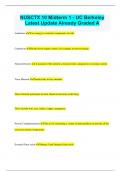
-
NUSCTX 10 Midterm 1 - UC Berkeley Latest Update Already Graded A
- Exam (elaborations) • 50 pages • 2024
-
Available in package deal
-
- $11.99
- + learn more
NUSCTX 10 Midterm 1 - UC Berkeley Latest Update Already Graded A Anabolism Uses energy to construct components of cells. Catabolism Breaks down organic matter, for example, to harvest energy. Nutrient Density A measure of the nutrient a food provides compared to its energy content. Trace Minerals Needed only in tiny amounts. These minerals participate in most chemical reactions in the body. These include iron, zinc, iodine, copper, manganese. Protein Complementation The act...

-
Testbank for Biology 2nd Edition from OpenStax College
- Exam (elaborations) • 57 pages • 2023
-
- $17.99
- 4x sold
- + learn more
Testbank for Biology 2nd Edition from OpenStax CollegeChapter 1 1 Figure 1.6 1: C; 2: F; 3: A; 4: B; 5: D; 6: E. The original hypothesis is incorrect, as the coffeemaker works when plugged into the outlet. Alternative hypotheses include that the toaster might be broken or that the toaster wasn't turned on. 3 Figure 1.16 Communities exist within populations which exist within ecosystems. 4 B 6 D 8 C 10 C 12 B 14 D 16 Answers will vary, but should apply the steps of the scientific method. One pos...
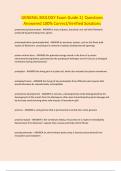
-
GENERAL BIOLOGY Exam Guide 2| Questions Answered 100% Correct/Verified Solutions
- Exam (elaborations) • 23 pages • 2024
- Available in package deal
-
- $12.99
- + learn more
protonema (protonemata) - ANSWER a mass of green, branched, one-cell-thick filaments produced by germinating moss spores protonephridium (protonephridia) - ANSWER an excretory system, such as the flame bulb system of flatworms, consisting of a network of tubules lacking internal openings proton-motive force - ANSWER the potential energy stored in the form of a proton electrochemical gradient, generated by the pumping of hydrogen ions (H+) across a biological membrane during chemiosmosis

-
Biology 1406: Exam 3 Latest Version Graded A+
- Exam (elaborations) • 14 pages • 2024
-
- $10.49
- + learn more
autotrophs an organism able to build all the complex organic molecules that it requires as its own food source heterotroph an organism that cannot derive energy from photosynthesis or inorganic chemicals , and so must feed on other plants and animals, obtaining chemical energy by degrading their organic molecules cellular respiration the oxidation of organic compounds to extract energy from chemical bonds dehydrogenation chemical reaction that involves the loss of a hydrogen atom, electro...
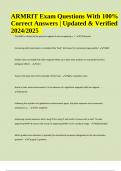
-
ARMRIT Exam Questions With 100% Correct Answers | Updated & Verified 2024/2025.
- Exam (elaborations) • 51 pages • 2024
-
- $16.49
- + learn more
ARMRIT Exam Questions With 100% Correct Answers | Updated & Verified 2024/2025. The NMV is rotated to the physical negative Z axis by applying a...? - C)180 pulse Increasing which parameter is considered the "best" technique for improving image quality? - C)NEX Studies have concluded that static magnetic fields up to what tesla produce no substantial harmful biological effects. - C)2.0 Tissues that have low (short) relaxation times have: - Higher relaxation rates Nuclei in their natural e...
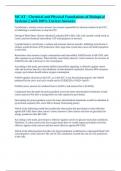
-
MCAT - Chemical and Physical Foundations of Biological Systems || with 100% Correct Answers.
- Exam (elaborations) • 16 pages • 2024
-
Available in package deal
-
- $11.99
- + learn more
Cytochrome c oxidase correct answers An enzyme responsible for electron transfer in the ETC, so inhibiting it would slow or stop the ETC. Dosing of Blast Phase Chronic Myeloid Leukemia (BP-CML) cells with cyanide would result in: correct answers Reduced intercellular ATP and apoptosis or necrosis. Cyanide binds to cytochrome c oxidase and prevents electron transfer. Inhibiting cytochrome C oxidase would decrease ATP production. thus, large dose would also cause cell death (apoptosis or ne...
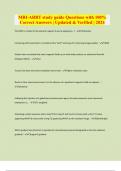
-
MRI-ARRT study guide Questions with 100% Correct Answers | Updated & Verified | 2024
- Exam (elaborations) • 47 pages • 2024
-
- $10.49
- + learn more
The NMV is rotated to the physical negative Z axis by applying a...? - C)180 pulse Increasing which parameter is considered the "best" technique for improving image quality? - C)NEX Studies have concluded that static magnetic fields up to what tesla produce no substantial harmful biological effects. - C)2.0 Tissues that have low (short) relaxation times have: - Higher relaxation rates Nuclei in their natural enviroment ( in the absence of a significant magnetic field) are aligned... - Ra...
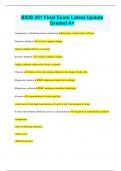
-
BIOS 251 Final Exam Latest Update Graded A+
- Exam (elaborations) • 12 pages • 2024
- Available in package deal
-
- $9.99
- + learn more
BIOS 251 Final Exam Latest Update Graded A+ Components of the homeostatic control loop receptor, control center, effector Negative feedback -works to oppose change -brings condition back to a set point Positive feedback -works to enhance change -brings condition further away from a set point Tonicity relates to how the solution influences the shape of body cells Hypotonic solution RBC undergoes hemolysis (swelling) Hypertonic solution RBC undergoes crenation (shrinki...

$6.50 for your textbook summary multiplied by 100 fellow students... Do the math: that's a lot of money! Don't be a thief of your own wallet and start uploading yours now. Discover all about earning on Stuvia


